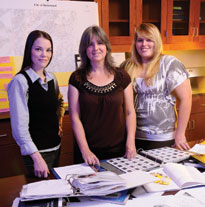Bringing Old Murder Cases Back from the Dead
By Gail Short
 |
Lindsay Duty (left), Kathrine Simmons (right), and Shannon Crock helped UAB forensic scientist Elizabeth Gardner (center) investigate a 1998 unsolved murder. |
On television, detectives can crack a murder case in less than an hour. But in the real world, criminal investigations often remain unsolved for years due to a lack of evidence, witnesses, or suspects.
“In a homicide case, the first 48 hours are critical,” says UAB forensic scientist Elizabeth Gardner, Ph.D. “The more time that passes, the harder the case is to solve.” But time also can be a detective’s friend, Gardner adds. New technologies appear on the scene, such as DNA tests, and witnesses who were once silent may become willing to talk.
Now students at UAB can learn firsthand how to crack these so-called cold cases in a new course that Gardner teaches with instructor John Grimes, J.D. Working in teams, students conduct a mock criminal investigation modeled on a real-life case. This spring it was a homicide resulting from a drug deal gone bad in Pennsylvania in the mid-1980s. Students examined old police reports and conducted interviews with witnesses—played by members of the UAB Mock Trial Team. The students then presented their case to Grimes, the “district attorney,” to request an arrest warrant. The course ended with a visit from investigator Rodney George, who solved the real case in 2002.
“The class exposes students to investigations and forensic science as well as to the process for conducting background checks, interviewing, creating a timeline, and organizing a case,” Gardner says. They also hear from guest speakers with expertise in cold case investigations.
In addition to the class, Gardner also developed the Cold Case Project. Its first investigation: to assist Homewood city detectives considering whether to reopen a 1998 case involving the death of a man gunned down in the parking lot of his apartment complex.
Gardner selected three master’s degree students to work on the project. For 10 months, the group gathered in a designated cold case room in the justice sciences department to organize police and forensic science reports, listen to witness statements, and discuss the available evidence—the first steps in reopening any cold case, Gardner says.
“I think every day we could look at that case and find something new,’” says student Lindsay Duty. “It took us about two months just to read it cover to cover and get familiar with all the names and people and places involved.” In May, the Homewood Police Department gave the three students a special commendation for their work.
More Information
Watch the video below to learn how to become a forensic scientist at UAB